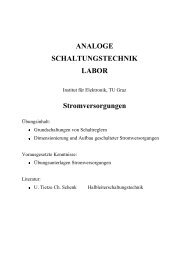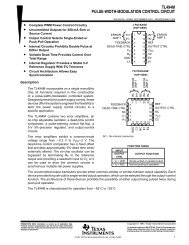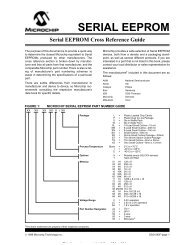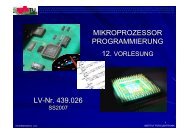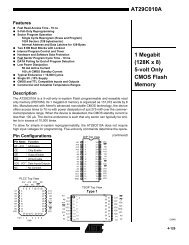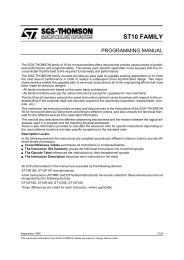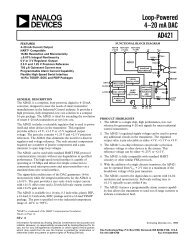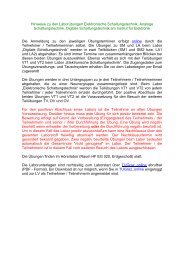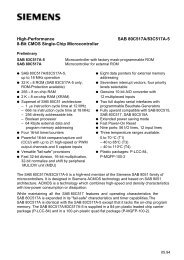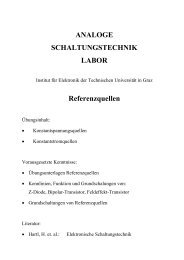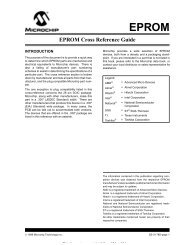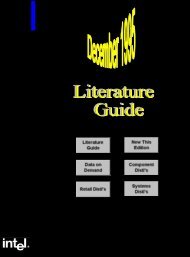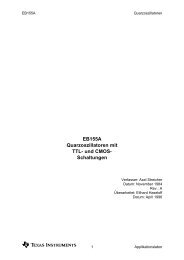AN61-1 Application Note 61 August 1994 Practical Circuitry for ...
AN61-1 Application Note 61 August 1994 Practical Circuitry for ...
AN61-1 Application Note 61 August 1994 Practical Circuitry for ...
Create successful ePaper yourself
Turn your PDF publications into a flip-book with our unique Google optimized e-Paper software.
<strong>Application</strong> <strong>Note</strong> <strong>61</strong>Some special considerations are required to optimizecircuit per<strong>for</strong>mance. L2’s very small inductance combineswith C2 to slightly retard the trigger pulse’s rise time. Thisprevents significant trigger pulse artifacts from appearingat the circuit’s output. C2 should be adjusted <strong>for</strong> the bestcompromise between output pulse rise time and purity.Figure 28 shows partial pulse rise with C2 properly adjusted.There are no discernible discontinuities related tothe trigger event.mandate a separate 12V supply and pulse <strong>for</strong>ming circuitry.Figure 29’s circuit provides the complete flashmemory programming function with a single IC and somediscrete components. All components are surface mounttypes, so little board space is required. The entire functionruns off a single 5V supply.L133µHMBRS130T3(MOTOROLA)5VSWITCHV INLT1109-12SHDN SENSEGND33µF+VPP FLASH V OUT 12V60mA0.2V/DIV1 = FLASH PROGRAM0 = STANDBYL1 = SUMIDA CD54-330<strong>AN<strong>61</strong></strong> • F29Figure 29. Switching Regulator Provides CompleteFlash Memory Programmer500 PICOSECONDS/DIV<strong>AN<strong>61</strong></strong> F28Figure 28. Expanded Scale View of Leading Edge IsClean with No Trigger Pulse Artifacts. DisplayGranularity Derives from Sampling OscilloscopeOperationQ1 may require selection to get avalanche behavior. Suchbehavior, while characteristic of the device specified, isnot guaranteed by the manufacturer. A sample of 50Motorola 2N2369s, spread over a 12 year date code span,yielded 82%. All “good” devices switched in less than600ps. C1 is selected <strong>for</strong> a 10V amplitude output. Valuespread is typically 2pF to 4pF. Ground plane type constructionwith high speed layout, connection and terminationtechniques are essential <strong>for</strong> a good results from this circuit.Flash Memory ProgrammerAlthough “Flash” type memory is increasingly popular, itdoes require some special programming features. The 5Vpowered memories need a carefully controlled 12V “VPP”programming pulse. The pulse’s amplitude must be within5% to assure proper operation. Additionally, the pulsemust not overshoot, as memory destruction may occur <strong>for</strong>VPP outputs above 14V. 8 These requirements usuallyThe LT1109-12 switching regulator functions by repetitivelypulsing L1. L1 responds with high voltage flybackevents, which are rectified by the diode and stored in the10µF capacitor. The “sense” pin provides feedback, andthe output voltage stabilizes at 12V within a few percent.The regulator’s “shutdown” pin provides a way to controlthe VPP programming voltage output. With a logical zeroapplied to the pin the regulator shuts down, and no VPPprogramming voltage appears at the output. When the pingoes high (trace A, Figure 30) the regulator is activated,producing a cleanly rising, controlled pulse at the output(trace B). When the pin is returned to logical zero, theoutput smoothly decays off. The switched mode deliveryof power combined with the output capacitor’s filteringprevents overshoot while providing the required pulseamplitude accuracy. Trace C, a time and amplitudeexpanded version of trace B, shows this. The outputsteps up in amplitude each time L1 dumps energy intothe output capacitor. When the regulation point is reachedthe amplitude cleanly flattens out, with only about 75mVof regulator ripple.<strong>Note</strong> 8: See Reference 17 <strong>for</strong> detailed discussion.<strong>AN<strong>61</strong></strong>-22



